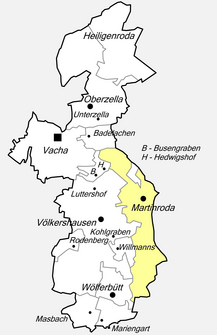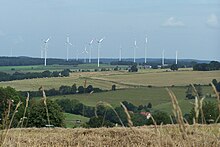Martinroda (Vacha)
|
Martinroda
City of Vacha
Coordinates: 50 ° 48 ′ 22 ″ N , 10 ° 4 ′ 13 ″ E
|
|
|---|---|
| Height : | 371 m above sea level NHN |
| Incorporation : | December 31 2013 |
| Postal code : | 36404 |
| Area code : | 036962 |
|
Location of Martinroda in Vacha
|
|
Martinroda is a district of the city of Vacha in the Wartburg district in Thuringia .
geography
The place Martinroda is in the Vorder Rhön about 11 km (air line) west of the district town Bad Salzungen .
mountains
The landscape around Martinroda, located in the hill country of Stadtlengsfeld , is characterized by the distinctive peaks of the eastern Kuppenrhön . This applies in particular to the mountains of Öchsen ( 627.2 m above sea level ) and Dietrichsberg ( 668.9 m above sea level ) to the west . The highest point in the Martinroda district is the Schorn ( 452.3 m above sea level ). The Riesenberg ( 378.4 m above sea level ) and the Hoppberg ( 378.1 m above sea level ) are also important.
Waters
The district lies in the Werra river system . The Oechse , with its tributaries Nussgraben and Schiegelbach, drains the northern, western and southern parts of the municipality; the eastern edge drains over the Riesengraben into the valley of the Felda and thus again into the Werra.
history
Prehistory and early history
The area around the mountain Oechsen was already a center of settlement in prehistoric times and was protected by the construction of fortifications on peaks. Excavation finds from the time of the Celts prompted the establishment of an open-air museum "Keltendorf" on the southwest slope of the Öchsenberg near Sünna in the 1990s .
Place name
The place name Martinroda is found on March 29, 1389 as the first recorded mention. A settlement Merbertsroda mentioned in Vacha was mentioned in the Frankenstein sales letter (1330). Martinroda is historically very closely connected to the neighboring village of Völkershausen, only 2 km away on the opposite side of the valley, where the parish church of Martinroda was located.
The rule of Völkershausen
The area around Martinroda belonged to the property and remaining parts of the area, which were sold by the Lords of Frankenstein in 1330 to the Counts of Henneberg . The Henneberger already owned a castle in Völkershausen in the 13th century and exercised lower jurisdiction. After the Frankensteiners, the Lords of Völkershausen took over the jurisdiction and administration of this area. Their castle complex was heavily fortified and was located in the upper part of the village (today's school grounds). When the Peasants' War broke out in the central Werra Valley, farmers from Martinroda also took part and joined the “Black Heap”. The militarily inexperienced farmers besieged the castle complexes in Völkershausen and Dietlas in vain at Easter 1525. They received reinforcements and weapons from the city of Vacha . The train in front of the town of Eisenach cost the Vacha Landsknechtshauptmann Hans Sippel and other leaders of the peasantry their lives, they had fallen into a trap. The uprising ended after the defeat in Frankenhausen with retaliatory measures by the sovereigns. The social tensions persisted, and religious tensions also became visible as a result of the Reformation movement , which was carried out intensively around Vacha, and the previously failed Anabaptist movement. Hans (the fifth) von Völkershausen (1481–1542) introduced the "Lutheran Faith" after the departure of the Catholic priest Michael Tratter in 1534. The first Protestant pastor was called Ludwig Landgraf.
Modern times
Around 1610 the place had just 17 houses. During the plague that was introduced in 1635, 35 people died, including the marching armies, namely the Croats, who did not spare the place. In 1707, the last lord of Völkershausen died, and Landgrave Karl von Hessen therefore took half of the court, as a failed Hersfeld fief , and also bought the allodial goods . As early as the 18th century, Völkershausen and the villages of Wölferbütt, Willmanns and Martinroda formed a special administrative case in the later Grand Duchy of Saxony-Weimar-Eisenach , a landgrave-Hessian patrimonial office, until the patrimonial courts were abolished. Martinroda received its own school in 1804.
The saying "The oxen learn to plow in Martinroda" was not an insult; rather, some farmers took on the necessary practice of tilling young oxen. This “ox school” was very successful and also helped the farmers to have well-plowed fields. In 1879, based on the census of 1875, statistical information on the town of Martinroda was published for the first time. As of the reporting date, it had 42 residential buildings with 240 residents. The size of the Martinrodaer Flur was at that time 209.8 ha, of which courtyards and gardens 7.4 ha, meadows 28.6 ha, arable land 129.1 ha, forest 6.7 ha, ponds, streams and rivers 0.1 ha Paths, drifts, wasteland and fruit plantations accounted for 37.8 hectares. The forest area was considerably enlarged in the 20th century by afforestation of low-yield fields on the Vacha border and the addition of a forest on the border to Wölferbütt and currently amounts to around 56% of the total area. The livestock: the Martinrodaer had 123 cattle, 82 sheep, 41 pigs and 12 goats.
The potash industry that began around the turn of the century also created jobs for the Martinroda population , and pits were built in the neighboring towns of Dietlas , Menzengraben and Merkers . The Völkershausen rockfall in March 1989 did not cause any major damage to the community . The bell installed in the newly built cemetery chapel also bears the inscription “God bless and receive Martinroda” to commemorate this event.
As of December 31, 2013, the place was incorporated into the city of Vacha .
Population development
Development of the population:
|
- Data source: from 1994 Thuringian State Office for Statistics - values from December 31st
Economy and Infrastructure
Established businesses
To the northwest of the village, around 15 modern wind turbines mark the wind park near Martinroda, which has been enlarged again with the energy transition. The power plant distributed over the plateau was built in the 1990s and uses the windy location of the site. The largest employer in town is the Rhön-Agrargenossenschaft eG Martinroda . The modern stables and storage buildings were built on the edge of the Busengraben settlement. This certified company has specialized in herdbook breeding of Limousin cattle and Z seeds and cultivates the fields and pastures in the vicinity of Martinroda.
traffic
Martinroda is connected to Vacha via the country road 2601 . The closest connection to the A4 is in Friedewald, Hesse .
The closest rail connection stations have been in Bad Salzungen , Bad Hersfeld and Eisenach since the Bad Salzungen – Vacha line was closed .
Martinroda is connected to the bus line 111 of the (Vacha - Oechsen - Völkershausen) transport companies Wartburg mobile to the public transport connected.
literature
- Olaf Ditzel, Walter Höhn: Vacha and the neighboring communities in the Oechsetal . Michael Imhof Verlag, Petersberg / Fulda 2011, ISBN 978-3-86568-121-8 , p. 25-27 .
Web links
Individual evidence
- ↑ a b Thuringian Land Survey Office TK25 - sheet 5126 Vacha , Erfurt 1997, ISBN 3-86140-062-6
- ^ C. Kronfeld, Regional Studies of the Grand Duchy of Saxony-Weimar-Eisenach. Second part. Weimar 1879.
- ↑ Verkehrsgesellschaft Wartburgmobil - regional transport offers and current timetables from June 1, 2019







